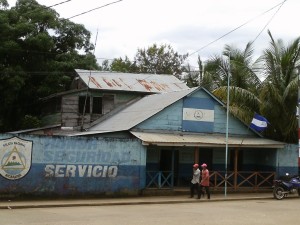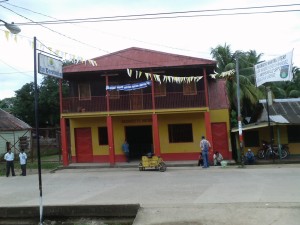Effective immediately, Rosita is my (Ben) home away from home. Already six workers are encamped in Rosita, starting to build our bamboo processing facilities and their future lodging. Another five will be freed from the construction of the Studio de Bambu in Granada (soon) and will join the first wave of workers.
Rosita is one of three small ethnic towns in the North East of Nicaragua that make up the “Las Minas” (the mining triangle) of Raan. These towns are surrounded by dense jungle and mountains, and the largest protected reserve areas in Nicaragua. The Moskito Coast as it is known, makes up 26% of total land area in Nicaragua yet encompases 5% of the population.
Let me describe Rosita as I currently have experienced it…
1. Transport into Rosita. There are two choices: One is to fly a 1940’s Soviet made aircraft for flight time of one hour – perfectly fine when air currents are smooth, or alternatively its a roller coaster ride that could put you off flying. The landing strip is a rough dirt road in the middle of a field scattered with cows. The plane seats eight people. You buy a ticket and you hope the reservation holds. You show up and hope there are enough people for the plane to fly and that you are one of them. Option two, is to drive on horrendous roads for twelve to sixteen hours depending on flat tires, road conditions and raging rivers. Most of the drive is through beautiful uninhabited terrain and dense forest.
2. The town is a one street town. Correct that… There are one and a half streets. Lining the streets are hardware stores (horse and mining equipment), one pharmacy, one restaurant, a now closed bank (no ATM), the lawyers office, the mayors office, the police station, a hotel and a few hospedajes. A few fruit and meat vendors and thats pretty much it.  Very reminiscent of a movie set for a Western in a gold mining to
Very reminiscent of a movie set for a Western in a gold mining to wn.
wn.
3.
Many men carry guns. The rule is the gun must be covered by ones’ shirt, thereby creating the omnipresent “gun bulge.”
4. Three languages that connect the population: Spanish, Mayagna and Meskito. All three languages are taught in school. The indigenous communities have their own territorial government.
5. Food is basic Nica fare, which means a staple of gallo pinto (rice and beans.) The restaurant has yielded not only the typical chicken and pork but three items of interest: Fresh fried fish which comes from the port two hours away, “paca” (a pig size rodent) which eats only grass and leaves and is quite tasty, and lastly the “venado” (venison) which I have not tried yet.